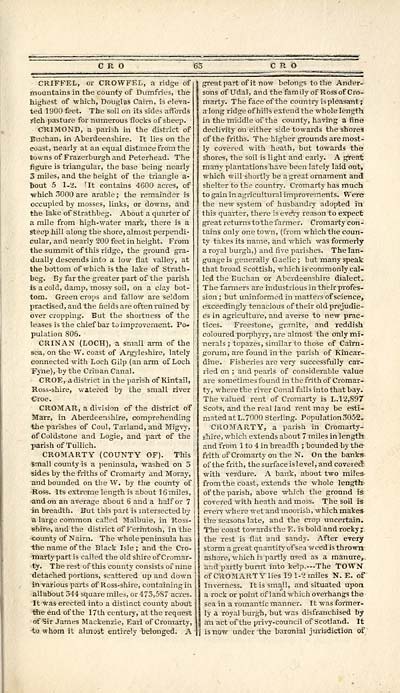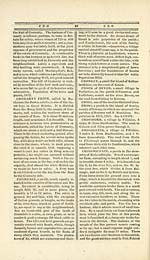Gazetteer of Scotland
(65) Page 63 - CRI
Download files
Complete book:
Individual page:
Thumbnail gallery: Grid view | List view

C R O
c n o
CRIFFEL, or CROWFEL, a ridge of
mountains in the county of Dumfries, the
highest of which, Douglas Cairn, is eleva-
ted 1 900 feet. The soil on its sides affords
rich pasture for numerous flocks of sheep.
CRIMOND, a parish in the district of
Buchan, in Aberdeenshire. Tt lies on the
coast, nearly at an equal distance from the
towns of Frazerburgh and Peterhead. The
figure is triangular, the base being nearly
3 miles, and the height of the triangle a-
bout 5 1-2. -It contains 4600 acres, of
which 3000 are arable ; the remainder is
occupied by mosses, links, or downs, and
the lake of Strathbeg. About a quarter of
a mile from high-water mark, there is a
steep hill along the shore, almost perpendi-
cular, and nearly 200 feet in height. From
the summit of this ridge, the ground gra-
dually descends into a low flat valley, at
the bottom of which is the lake of Strath-
beg. By far the greater part of the parish
is a cold, damp, mossy soil, on a clay bot-
tom. Green crops and fallow are seldom
practised, and the fields are often ruined by
over cropping. But the shortness of the
leases is the chief bar to improvement. Po-
pulation 806.
CRINAN (LOCH), a small arm of the
sea, on the W. coast of Argyleshire, lately
connected with Loch Gilp (an arm of Loch
Fyne), by the Crinan Canal.
CROE, a district in the parish of Kintail,
Ross-shire, watered by the small river
€roe.
CROMAR, a division of the district of
Marr, in Aberdeenshire, comprehending
the parishes of Coul, Tarland, and Migvy,
of Coldstone and Logie, and part of the
parish of Tullich.
CROMARTY (COUNTY OF). This
small county is a peninsula, washed on 5
sides by the friths of Cromarty and Moray,
and bounded on the W. by the county of
Ross. Its extreme length is about 16 miles,
■and on an average about 6 and a half or 7
in breadth. But this part is intersected by
a large common called Malbuie, in Ross-
shire, and the district of Ferintosh, in the
county of Nairn. The whole peninsula has
the name of the Black Isle; and the Cro-
marty part is called the old shire of Cromar-
ty. The rest of this county consists of nine
detached portions, scattered up and down
in -various parts of Ross-shire, containing in
allabout 344 square miles, or 473,5S7 acres.
It was erected into a distinct county about
the end of the 17th century, at the request
of Sir James Mackenzie, Earl of Cromarty,
to whom it almost entirely belonged. A
great part of it now belongs to the Ander-
sons of Udal, and the family of Ross of Cro-
marty. The face of the country ispleasant;
a long ridge of hills extend the whole length
in the middle of the county, having a fine
declivity on either side towards the shores
of the friths. The higher grounds are most-
ly covered with heath, but towards the
shores, the soil is light and early. A great
many plantations have been lately laid out,
which will shortly be a great ornament and
shelter to the country. Cromarty has much
to gain in agricultural improvements. Were
the new system of husbandry adopted in
this quarter, there is eve"ry reason to expect
great returns to the farmer. Cromarty con-
tains only one town, (from which the coun-
ty takes its name, and which was formerly
a royal burgh,) and five parishes. The lan-
guage is generally Gaelic ; but many speak
that broad Scottish, which iscommonly cal-
led the Euchan or Aberdeenshire dialect.
The farmers are industrious in their profes-
sion ; but uninformed in matters of science,
exceedingly tenacious of their old prejudic-
es in agriculture, and averse to new prac-
tices. Freestone, granite, and reddish
coloured porphyry, are almost the only mi-
nerals ; topazes, similar to those of Cairn-
gorum, are found in the parish of Kincar-
dine. Fisheries are very successfully car-
ried on ; and pearls of considerable value
are sometimes found in the frith of Cromar-
ty, where the river Conal falls into that bay.
The valued rent of Cromarty is L.12,S97
Scots, and the real land rent may be esti-
mated at L.7000 Sterling. Population 3052,
CROMARTY, a parish in Cromarty-
shire, which extends about 7 miles in length
and from 1 to 4 in breadth ; bounded by the
frith of Cromarty on the N. On the banks
of the frith, the surface is level, and covered'
with verdure. A bank, about two mileg
from the coast, extends the whole length
of the parish, above which the ground is
covered with heath and moss. The soil is
every where wet and moorish, which makes
the seasons late, and the crop uncertain.
The coast towards the E. is bold and rocky;
the rest is flat and sandy. After every
storm a great quantity of sea weed is thrown
ashore, which is partly used as a manure,.
and partly burnt into kelp.— The TOWN
of CROMARTY lies 19 1-2 miles N. E. of
Inverness. It is small, and situated upon
a rock or point of land which overhangs the
sea in a romantic manner. It was former-
ly a royal burgh, but was disfranchised by
an act of the privy-council of Scotland. It
is now under the baronial jurisdiction of
c n o
CRIFFEL, or CROWFEL, a ridge of
mountains in the county of Dumfries, the
highest of which, Douglas Cairn, is eleva-
ted 1 900 feet. The soil on its sides affords
rich pasture for numerous flocks of sheep.
CRIMOND, a parish in the district of
Buchan, in Aberdeenshire. Tt lies on the
coast, nearly at an equal distance from the
towns of Frazerburgh and Peterhead. The
figure is triangular, the base being nearly
3 miles, and the height of the triangle a-
bout 5 1-2. -It contains 4600 acres, of
which 3000 are arable ; the remainder is
occupied by mosses, links, or downs, and
the lake of Strathbeg. About a quarter of
a mile from high-water mark, there is a
steep hill along the shore, almost perpendi-
cular, and nearly 200 feet in height. From
the summit of this ridge, the ground gra-
dually descends into a low flat valley, at
the bottom of which is the lake of Strath-
beg. By far the greater part of the parish
is a cold, damp, mossy soil, on a clay bot-
tom. Green crops and fallow are seldom
practised, and the fields are often ruined by
over cropping. But the shortness of the
leases is the chief bar to improvement. Po-
pulation 806.
CRINAN (LOCH), a small arm of the
sea, on the W. coast of Argyleshire, lately
connected with Loch Gilp (an arm of Loch
Fyne), by the Crinan Canal.
CROE, a district in the parish of Kintail,
Ross-shire, watered by the small river
€roe.
CROMAR, a division of the district of
Marr, in Aberdeenshire, comprehending
the parishes of Coul, Tarland, and Migvy,
of Coldstone and Logie, and part of the
parish of Tullich.
CROMARTY (COUNTY OF). This
small county is a peninsula, washed on 5
sides by the friths of Cromarty and Moray,
and bounded on the W. by the county of
Ross. Its extreme length is about 16 miles,
■and on an average about 6 and a half or 7
in breadth. But this part is intersected by
a large common called Malbuie, in Ross-
shire, and the district of Ferintosh, in the
county of Nairn. The whole peninsula has
the name of the Black Isle; and the Cro-
marty part is called the old shire of Cromar-
ty. The rest of this county consists of nine
detached portions, scattered up and down
in -various parts of Ross-shire, containing in
allabout 344 square miles, or 473,5S7 acres.
It was erected into a distinct county about
the end of the 17th century, at the request
of Sir James Mackenzie, Earl of Cromarty,
to whom it almost entirely belonged. A
great part of it now belongs to the Ander-
sons of Udal, and the family of Ross of Cro-
marty. The face of the country ispleasant;
a long ridge of hills extend the whole length
in the middle of the county, having a fine
declivity on either side towards the shores
of the friths. The higher grounds are most-
ly covered with heath, but towards the
shores, the soil is light and early. A great
many plantations have been lately laid out,
which will shortly be a great ornament and
shelter to the country. Cromarty has much
to gain in agricultural improvements. Were
the new system of husbandry adopted in
this quarter, there is eve"ry reason to expect
great returns to the farmer. Cromarty con-
tains only one town, (from which the coun-
ty takes its name, and which was formerly
a royal burgh,) and five parishes. The lan-
guage is generally Gaelic ; but many speak
that broad Scottish, which iscommonly cal-
led the Euchan or Aberdeenshire dialect.
The farmers are industrious in their profes-
sion ; but uninformed in matters of science,
exceedingly tenacious of their old prejudic-
es in agriculture, and averse to new prac-
tices. Freestone, granite, and reddish
coloured porphyry, are almost the only mi-
nerals ; topazes, similar to those of Cairn-
gorum, are found in the parish of Kincar-
dine. Fisheries are very successfully car-
ried on ; and pearls of considerable value
are sometimes found in the frith of Cromar-
ty, where the river Conal falls into that bay.
The valued rent of Cromarty is L.12,S97
Scots, and the real land rent may be esti-
mated at L.7000 Sterling. Population 3052,
CROMARTY, a parish in Cromarty-
shire, which extends about 7 miles in length
and from 1 to 4 in breadth ; bounded by the
frith of Cromarty on the N. On the banks
of the frith, the surface is level, and covered'
with verdure. A bank, about two mileg
from the coast, extends the whole length
of the parish, above which the ground is
covered with heath and moss. The soil is
every where wet and moorish, which makes
the seasons late, and the crop uncertain.
The coast towards the E. is bold and rocky;
the rest is flat and sandy. After every
storm a great quantity of sea weed is thrown
ashore, which is partly used as a manure,.
and partly burnt into kelp.— The TOWN
of CROMARTY lies 19 1-2 miles N. E. of
Inverness. It is small, and situated upon
a rock or point of land which overhangs the
sea in a romantic manner. It was former-
ly a royal burgh, but was disfranchised by
an act of the privy-council of Scotland. It
is now under the baronial jurisdiction of
Set display mode to: Large image | Transcription
Images and transcriptions on this page, including medium image downloads, may be used under the Creative Commons Attribution 4.0 International Licence unless otherwise stated. ![]()
| Gazetteers of Scotland, 1803-1901 > Gazetteer of Scotland > (65) Page 63 - CRI |
|---|
| Permanent URL | https://digital.nls.uk/97422474 |
|---|

